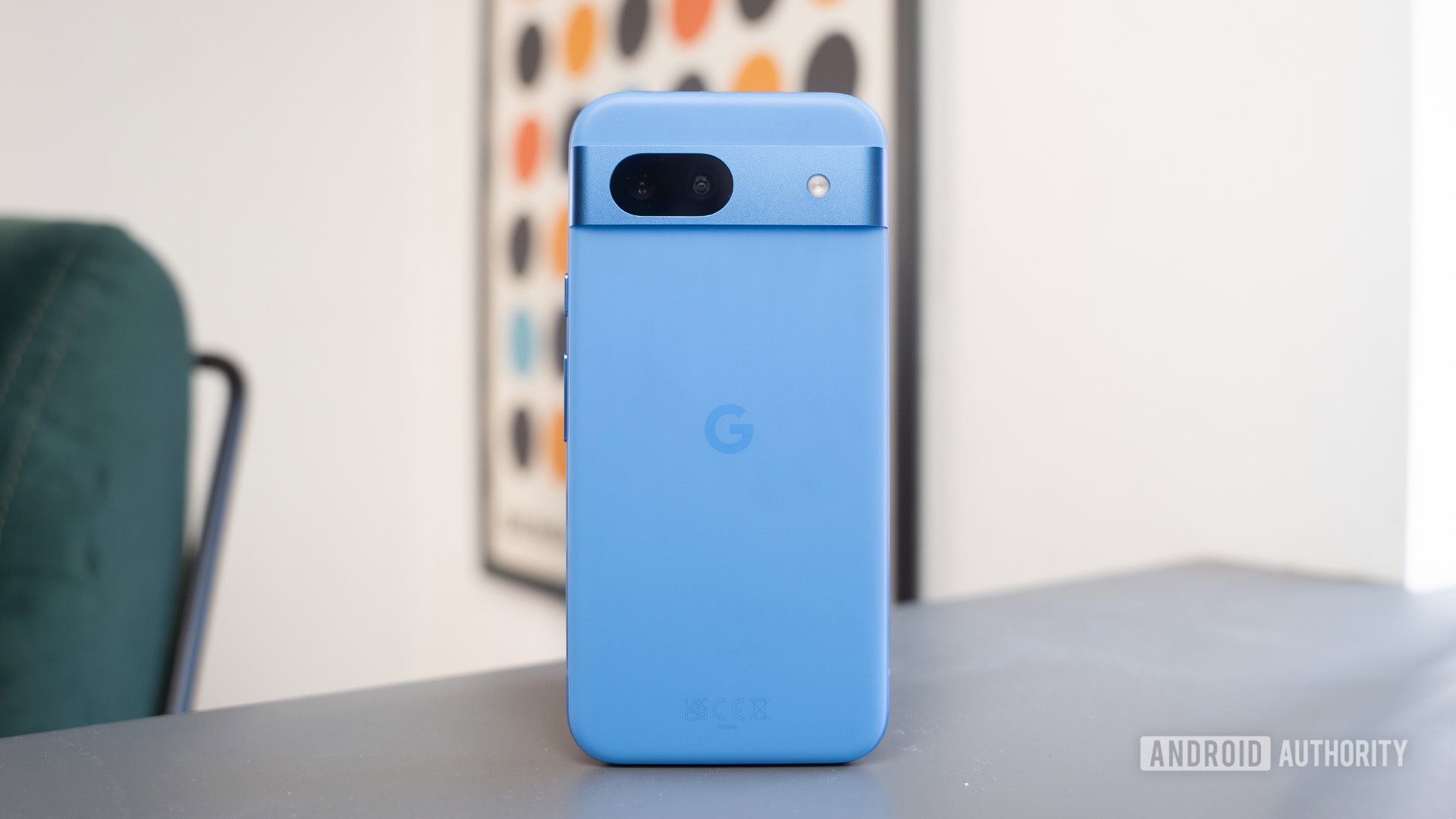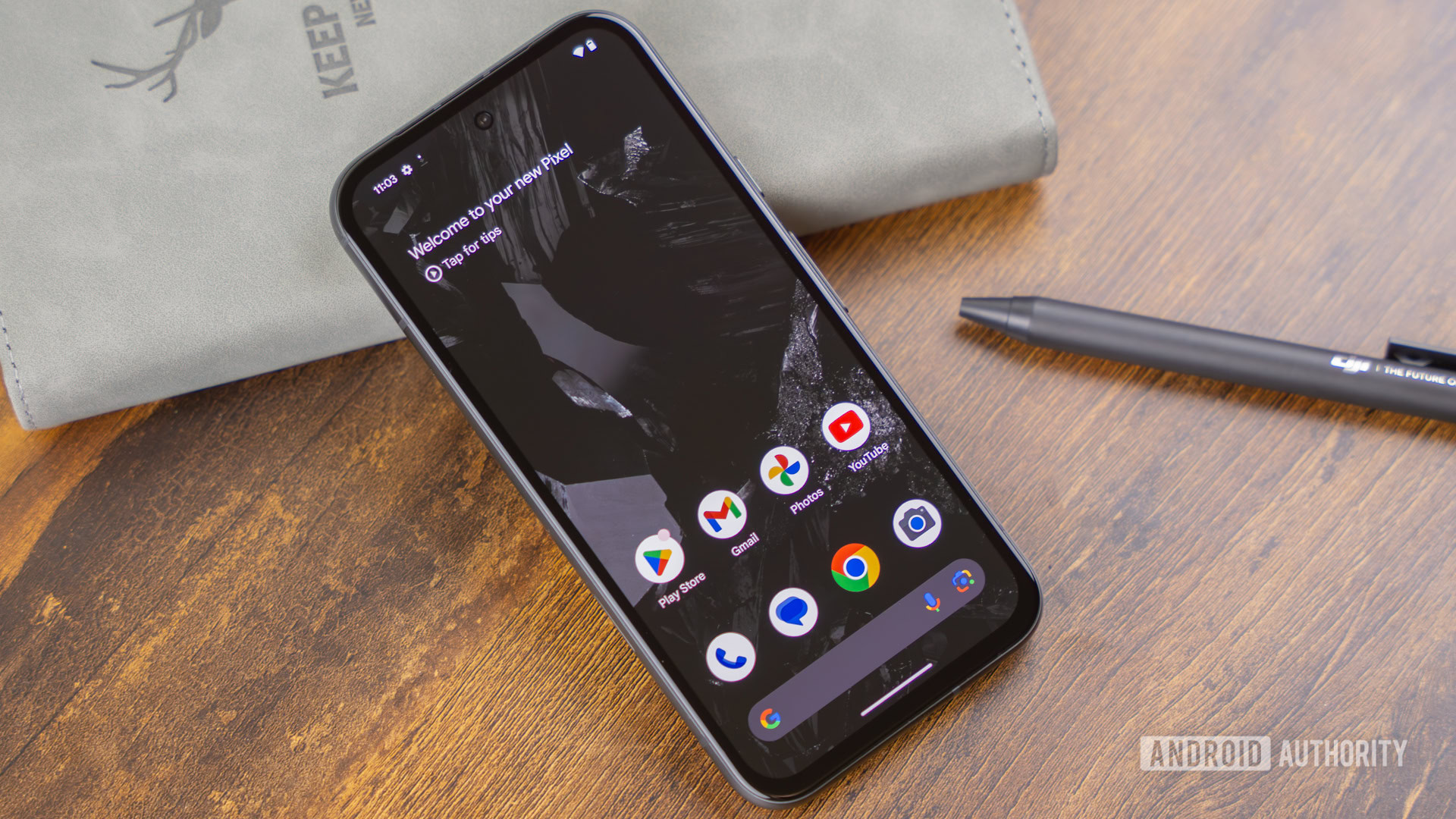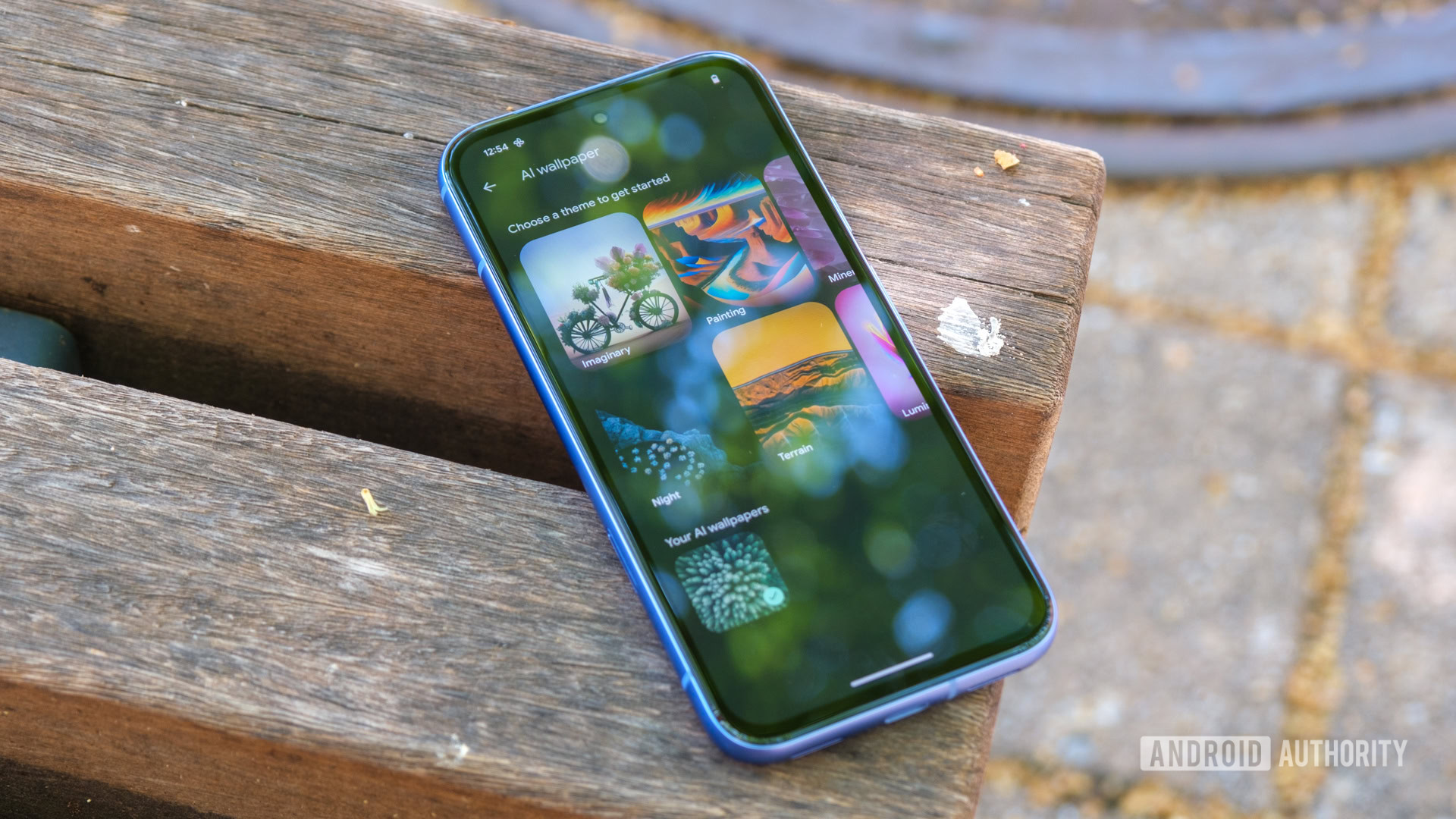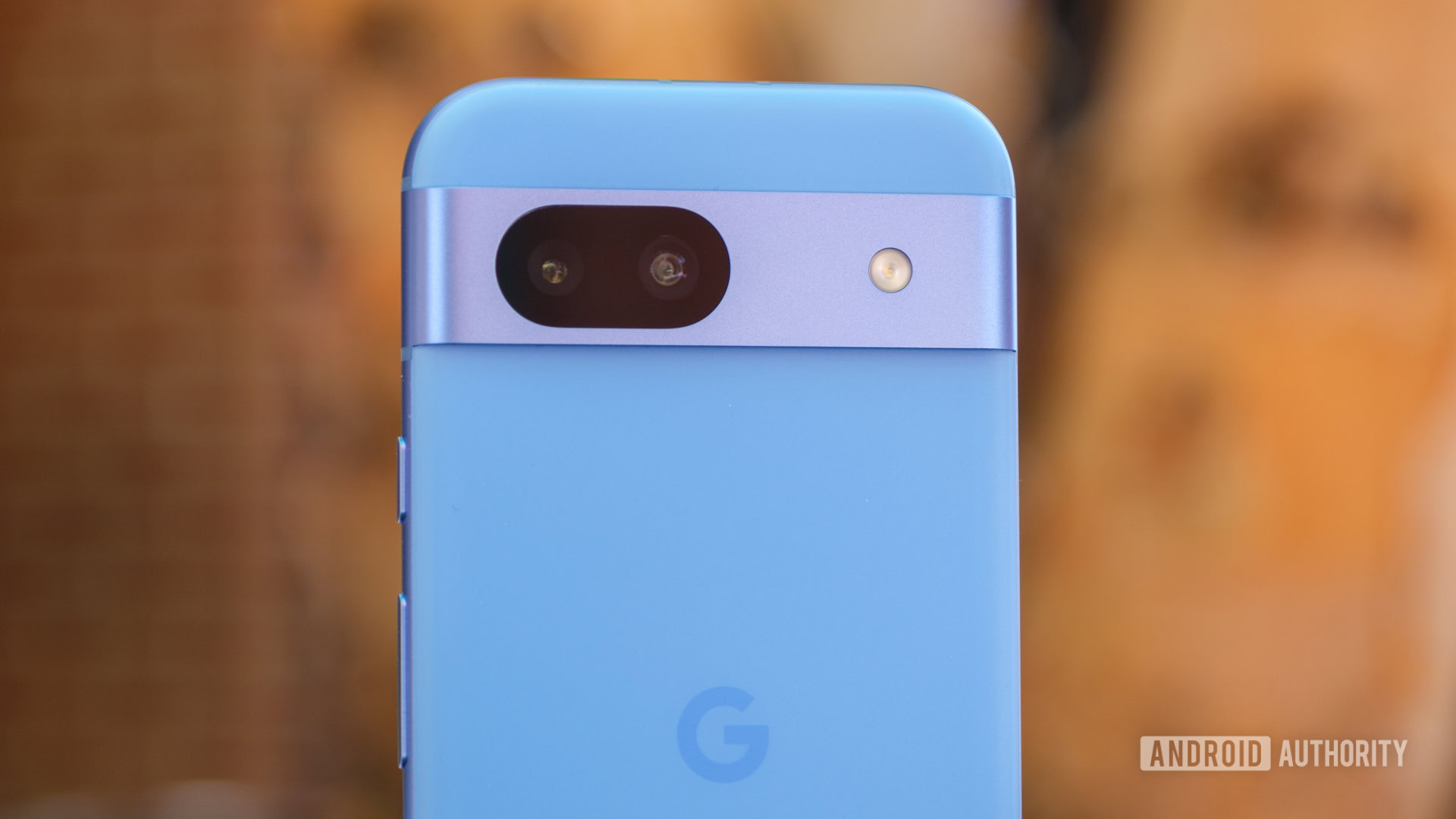Affiliate links on Android Authority may earn us a commission. Learn more.


Google Pixel 8a review: Should you buy it?
Published onMarch 19, 2025

Google Pixel 8a
MSRP: $499.00
What we like
What we don't like

Google Pixel 8a
Google Pixel 8a review: At a glance
- What is it? The Pixel 8a is Google's mid-range Android smartphone launched in 2024 as the third and final member of the Tensor G3-powered Pixel 8 family. It replaces the Google Pixel 7a with a slightly bigger battery, identical camera hardware, and a new, rounded design. It's succeeded by the Pixel 9a, launched in March 2025.
- What is the price? The Google Pixel 8a costs $499 with 128GB of storage, or you can upgrade to 256GB for $559. In the UK, the Pixel 8a will set you back £499 or £559 with the same storage options.
- Where can you buy it? The Google Pixel 8a is available either unlocked through the Google Store and retailers like Amazon and Best Buy or on a contract through carriers like Verizon, T-Mobile, and AT&T.
- How did we test it? I tested the Google Pixel 8a for two weeks. The review unit was supplied by Google. Our wider editorial team also tested several other Pixel 8a retail units purchased by Android Authority for battery, performance, and charging data, as well as camera samples.
- Is it worth it? The Google Pixel 8a is an excellent mid-ranger that finds new ways to pack value into its $500 price tag. It offers a best-in-class update commitment with one of the cleanest Android skins and plenty of AI-powered features. It has a lot in common — perhaps too much — with both its predecessor and flagship counterpart, each with perks of its own, but you won't find a better smartphone under $500 at MSRP.
Should you buy the Google Pixel 8a?

Google’s mid-range Pixel A series exists in a confusing space. On the one hand, it offers much of the flagship Pixel experience with the same powerful image processing, sleek, colorful design, and smooth Android skin with a long-term update commitment — all good things. However, the Pixel A series exists at a price that, year after year, falls just a bit too close to Google’s base Pixel flagship when you account for the hefty discounts that tend to drop at the same time as the Pixel A series’ typical mid-year launch window. It started with the Pixel 6 series and continued with the Pixel 7 series, and now Google is back for another bite at the apple with the $500 Pixel 8a. On paper, it’s a capable budget Pixel device, but can it survive in a world where the Google Pixel 8 is almost always on sale for just $100 more and the Pixel 9a is looming large over it?
Obviously, stepping on its own toes doesn’t always work out for Google (or anyone else), but when it comes to the Pixel 8a’s design, it really, really does. I’ve always been partial to the Pixel’s camera bar and bright color options, and this mid-ranger takes them to new heights — just don’t expect top-shelf materials. At a glance, the Pixel 8a looks like a scaled-down cross between the Pixel 8 and Pixel 8 Pro, pulling the size of the former and combining it with the soft matte finish of the latter. But having held and tested all of them extensively at this point, I can tell you that the mid-ranger has rounder corners than either flagship, making it feel like a pebble you just fished out of a stream.
Maybe you’re anti-pebble, but the change makes the Pixel 8a fit perfectly in the hand. It doesn’t dig in nearly as much as its flagship counterparts, and its fingerprint-resistant finish is much appreciated when most budget phones opt for high-gloss finishes to look more premium. Although cutting corners works out well for the overall design, it’s not quite as welcome when it comes to the Pixel 8a’s materials. For a cool $499, you get a phone with a Gorilla Glass 3 display, aluminum frame, and colorful (see all the colors in hands-on images at the link) composite back — which is just a nice word for plastic. Low-grade Gorilla Glass and plastic are what we expect on actual budget phones, not mid-rangers that cost more than Samsung’s Galaxy A35 5G, a phone with Gorilla Glass Victus Plus protecting the display. On the brighter side, the Pixel 8a offers an IP67 rating against water and dust.
Another bright side (pun intended) is that the Pixel 8a features almost the same display as the Pixel 8 — just smaller and slightly less durable. It boasts the same 1,080 x 2,400 resolution and 60 to 120Hz refresh rate in a slightly smaller 6.1-inch panel. The Pixel 8a’s OLED panel also tops out at up to 2,000 nits of peak brightness. However, you should know that you need to opt into the semi-variable refresh rate, as the Pixel 8a is locked at 60Hz by default. Both settings feel smooth while using the Pixel 8a from day to day, though I appreciate the extra speed while scrolling through X or checking on Google Discover. The Pixel 8a’s display also houses its fingerprint reader, identical to the one on the Pixel 8 series. I haven’t had any issues with accuracy or speed, and the position is just high enough on the display to be comfortable.
Google might have skimped on the Pixel 8a's materials, but it nailed the overall design.
Moving on, perhaps the best reason to reach for the Pixel 8a over an older Pixel device is the software experience. You get the light, smooth, Google-ified Android experience you’d find on a flagship Pixel, and it’s combined with the same class-leading update commitment as the Pixel 8 series and newer Pixel 9 series. That means the Pixel 8a will get seven years of Pixel updates, including Android versions, security patches, and regular feature drops, which not only beats other Android devices in its price range but tops flagship-level promises from OnePlus and Motorola and also betters Samsung’s mid-to-budget phone update policies.
In addition to the long-term support, Google’s Pixel 8a is chock-full of AI-powered features, many of which we saw for the first time on the Pixel 8 series. It even picked up a few new wrinkles from the time it launched until our six-month revisit. I’ve become a true believer in AI-generated wallpapers, using just a few prompts to switch up the look of my Pixel 8a every few days. On a more practical front, Google’s Circle to Search feels like the next step in Google Lens and a far more practical application of what AI-centric upstarts like Rabbit want their “vision modes” to be.

You can also tap into more advanced AI-powered features through Google’s Gemini platform, including summarizing emails and documents and brainstorming ideas for your next DIY project. Interestingly, the Gemini app isn’t installed on the Pixel 8a by default, so you’ll have to grab it from the Play Store. You’ll also have to switch your active assistant from Google Assistant to Gemini, removing some of the features you’re used to. Google has also confirmed that the Pixel 8a will get Gemini Nano on-device AI support in a future feature drop, which should enable more advanced features in the future (though you’ll need to dig into the phone’s developer settings to enable it).
Of course, one of the keys to Google’s AI-powered goals is its Tensor G3 chipset. Although we’ve mentioned more than once that the Tensor G3 doesn’t quite match rivals like Qualcomm’s Snapdragon 8 Gen 3 regarding flagship performance on the best Android phones, it feels right at home in the $500 segment. It still doesn’t set the world on fire with class-leading benchmark scores across the board, but it does put up a pretty good fight against the more expensive Nothing Phone 2 and Samsung Galaxy S23 FE. Samsung and Nothing have a very slight edge in the CPU-focused Geekbench 6 test with a bit of a wider margin in the overall PCMark Work test, but the three phones are almost indistinguishable in our 20-minute 3DMark graphics stress test — not bad, Google.
In a more practical, day-to-day sense, the Pixel 8a has no problem keeping up with its mid-range rivals. The Pixel 8a accompanied me on several days’ worth of travel, flying to Boston to visit my brother and then heading to New York for a work event, and I never felt stressed over how it would handle a long day. It hopped comfortably from social media scrolling to light gaming, all with downloaded Spotify podcasts streaming in the background. Google has also mostly addressed the Tensor G3’s thermal issues — the Pixel 8a never really warmed under basic usage — though I noticed a little extra warmth when searching for a connection after pulling the phone out of airplane mode. Check out our Pixel 8a performance deep dive (or watch the video above) for more details on what to expect.

Moving on, what Google Pixel device is complete without a capable set of cameras? We all know that Google isn’t the fastest to change or upgrade its camera sensors when it’s already among the best on a budget phone, so it’s hardly surprising to see the Pixel 8a land with the same dynamic duo as its predecessor. That means you’ll use the 64MP primary sensor — which bins to 16MP images by default — for the bulk of your shooting. It’s again paired with a 13MP ultrawide camera, complete with a 120-degree field of view. Even the selfie camera offers the same 13MP resolution, though it has a slightly wider 96.5-degree field of view — up from an even 95 degrees.
The main differences, however, come when you look at the Pixel 8a’s software features. It has a few new Tensor G3-powered extras, like Best Take and Audio Magic Eraser, which let you swap faces in your group photos and clean up background noise from your videos, respectively. The Pixel 8a also adds Magic Editor to the mix, which is the next step in the evolution of Magic Eraser, enabling you to move and resize subjects in your shots and use AI to fill in the space. I’ll admit that they all sound like cool features and are fun to play around with, but the artifacts that AI sometimes leaves behind make it tough to use Magic Editor results for much more than social media throwaways.
As mentioned, you’ll probably use the 64MP primary sensor to capture most of your images. Not because it’s an excellent sensor (though it is pretty good), but because there’s no telephoto option to zoom with. So, I’d wager you’ll spend most of your time split between the 1x and 2x zoom lengths, as that’s where the sensor feels most at home. The Pixel 8a nailed both the colors and the fine details in the collection of samples below, bringing the bright green of New York’s High Line to life in the top left but also pulling out the bright colors in the rack of kayaks without oversaturating them on an overcast day.
I’m also pleased with the Pixel 8a’s low-light performance, as seen in the image in the second row. It accurately captured the colors of the sunset and the architecture of the Saratoga Performing Arts Center, even if it couldn’t help me get a better view of the concert itself. True Night Sight is a little tougher for the Pixel 8a due to its slightly smaller megapixels, but it still captured accurate colors with a two-second exposure, as seen below. There’s also decent detail throughout the grass, and you can easily see both the sky and clouds between the trees. It’s just about identical to the performance we’ve seen from the Pixel 8 in low light, though the flagship’s larger individual megapixels might let it capture more light just a bit faster.
Although the Pixel 8a is perfectly comfortable at 1x and 2x zoom, it’s a little less confident once you pinch in further. Both the 4x and 8x zoom samples below show the limitations of digital zoom, holding onto the correct colors pretty effectively but losing the details in the boards of the dock and the rocks behind the boat. The boat’s name also comes out a bit fuzzy at the 8x zoom length, despite not being all that far away.
Thankfully, Google’s 13MP ultrawide camera makes the Pixel 8a much more reliable at 0.5x zoom. It’s the same field of view as we saw on the Pixel 7a, but it just seems to work well, especially in the heights of New York City. I particularly like the shot of the apartment building to the left, as the wider perspective helps to emphasize the funky architecture. There’s a little bit of lens flare, which is less appreciated, but the colors are again spot-on.
I don’t have many complaints about the punch hole selfie camera either — it doesn’t need to bin by default, and it hands in results with good colors and details. Best of all, Google doesn’t worry about the beauty filters we sometimes see on other budget phones. However, I can’t make heads or tails of the Pixel 8a’s default selfie portrait options. Your options are 1.7x and 2x zoom, and they’re almost impossible to tell apart.
On the video side, adding Audio Magic Eraser is the Pixel 8a’s only major upgrade. Otherwise, it’s still capable of 4K or 1080p recording at 60fps from either rear camera and up to 30fps from the selfie camera, just like the previous Pixel 7a. That said, Google seems to have improved its video stabilization — clips from the Pixel 8a have noticeably less bounce while walking than clips from the Pixel 7a. You can also check out full-size versions of the samples above and several more at this Google Drive link.
The last piece of Google’s Pixel 8a puzzle is its battery and charging setup. Although the phone is almost the same size as its predecessor, it has a battery about 100mAh larger, and the switch to the Tensor G3 chip means it can push that battery a bit further. Our controlled battery drain test showed that the newer mid-ranger easily beats the older Pixel 7a in simulated zoom calls, camera longevity in both video and stills, and 4K video playback, and comes up just a bit short in basic web browsing and gaming. The differences aren’t that big, though, and you might not notice them across a mixed day of usage since they’ll likely balance each other out.
Unfortunately, the similarities continue when you eventually run the Pixel 8a out of juice. It still offers the same speeds as the Pixel 7a, topping out at 18W wired and 7.5W wireless charging, neither of which is great in 2025. Motorola’s much cheaper Moto G Power (2024), for example, outpaces both charging standards — even if it can’t keep up in any other regard. In our experience, the Pixel 8a took a full 100 minutes to charge, which is, as my colleague Rob Triggs pointed out, slower than the Galapagos Tortoise runs the 400-meter dash. Oh, and you don’t get a charger in the box, so you might want to check out a few of our favorite Pixel 8a chargers if you think you’ll need to upgrade.
So, is the Pixel 8a Google’s most complete mid-range Android phone to date? Yes, certainly. It has the best update commitment for the money, solid performance, an ever-growing list of AI-powered features, and a design almost as good as the Pixel 5 (a phone I still miss). And, if you’re lucky, your carrier might offer you one for free.
However, the Pixel 8a also has so much in common with its predecessor and its flagship Pixel 8 counterpart that if you find the vanilla flagship on sale for around the $600 mark (something we’ve already seen multiple times in the past month or so), you should 100% ignore that the Pixel 8a exists and grab the better phone. You can save money and get the same cameras and charging experience from the Pixel 7a or splash some cash for better materials, faster charging, slightly better camera flexibility, and a larger display. The new Pixel 9a also looks a far more impressive device on paper at the same $499 price.
In a vacuum, Google has nailed the Pixel 8a; it’s a phone that no one would ever be unhappy with, but one that’s also been dropped into a no-win situation of Google’s own creation.


What are the best Google Pixel 8a alternatives?
You may have come this far only to realize that the Google Pixel 8a is not, in fact, the phone for you. If that’s the case, several others with similar specs and price tags are worth considering. Here are just a few Pixel 8a alternatives:
- Google Pixel 9a ($499 at Amazon): Google’s 2025 budget Pixel phone offers several upgrades over its predecessor at the same launch price. It includes a much larger battery with faster charging, a slightly larger display, and the Tensor G4 SoC.
- Google Pixel 9 ($799 at Amazon): You knew this was coming first — the Pixel 9 is essentially a more complete Pixel 8a, offering better materials in an updated design, faster charging speeds, and more capable cameras on the front and back. Check out our full written comparison, or watch the video above for more.
- Samsung Galaxy A35 5G ($359.99 at Amazon): If you’re not sold on Google’s Pixel ecosystem, the Galaxy A35 5G offers a great experience at a lower price. It combines Gorilla Glass Victus Plus with a flexible three-camera setup and Samsung’s unusual Key Island design for the power button and volume rocker. With no Galaxy A5X series phone in the US in 2024, it’s the closest Samsung has to a Pixel 8a competitor without you making the jump to the pricier Galaxy S23 FE.
- Google Pixel 7a ($477 at Amazon): The outgoing Pixel 7a has plenty in common with the updated Pixel 8a, but you can grab it at a better price on sale. It has identical rear cameras and charging specs, though it misses the seven years of software support.
- OnePlus 12R ($599.99 at Amazon): OnePlus is back to offering multiple flagships per year, or at least a flagship and a premium mid-range option. The OnePlus 12R offers the fastest wired charging on this list, as well as a durable Gorilla Glass Victus 2 display and a powerful Snapdragon 8 Gen 2 processor.
- Nothing Phone 2a Plus ($417.5 at Amazon): Although it’s only available in the US via a developer scheme and doesn’t have broad US carrier support, the Nothing Phone 2a Plus is one of the best and quirkiest mid-range Android phones you can buy. It looks like a rejected (but cute) design from the movie Wall-E and comes with a pair of 50MP cameras on the back and a massive display.
Google Pixel 8a specs
| Google Pixel 8a | |
|---|---|
Display | 6.1-inch OLED 120Hz refresh rate 2400 x 1080 resolution 20:9 aspect ratio |
Processor | Google Tensor G3 |
RAM | 8GB |
Storage | 128/256GB |
Battery | 4.492mAh 18W wired charging 7.5W wireless charging No charger included |
Cameras | Rear: 64MP wide camera ƒ/1.89 aperture OIS + EIS 13MP ultra-wide camera, 120deg FoV ƒ/2.2 aperture Front: 13MP (f/2.2) |
Connectivity | 5G 4G LTE Wi-Fi 6e Bluetooth 5.3 NFC |
Operating System | Pixel UI Android 14 |
Water resistance | IP67 |
Colors | Aloe, Bay, Obsidian, Porcelain |
Dimension and weight | 152.4 x 73.7 x 10.1mm 192.8 grams |
Google Pixel 8a review: FAQ
Google’s flagship Pixel 8 uses Gorilla Glass Victus on the front and back and offers faster charging speeds, a better IP rating, and slightly more flexible cameras than the partly plastic Pixel 8a.
Yes, the Pixel 8a charges wirelessly at up to 7.5W.
No, the Pixel 8a does not have a headphone jack. Google removed the headphone jack from its Pixel A series after the Pixel 5a.
The Google Pixel 8a has an IP67 rating against water and dust, which means it can withstand submersion in water for up to 30 minutes.
Yes. The Pixel 8a has a single nano-SIM tray but supports dual-SIM with downloadable eSIM profiles.
Yes, the Google Pixel 8a supports NFC.
Yes, the Pixel 8a supports 5G.